Open dates in 2024: March 4-8, 11-15, Apr 8-12, 15-19, May 24-31, June 21-28, July 24-31, August 17-25, Sept 2-6, 9-10, 11am-1pm, 3pm-5pm
Fee: adult/OAP/student €10, child under 12 free

2024 Diary of Irish Historic Houses (section 482 properties)
To purchase an A5 size 2024 Diary of Historic Houses (opening times and days are not listed so the calendar is for use for recording appointments and not as a reference for opening times) send your postal address to jennifer.baggot@gmail.com along with €20 via this payment button. The calendar of 84 pages includes space for writing your appointments as well as photographs of the historic houses. The price includes postage within Ireland. Postage to U.S. is a further €10 for the A5 size calendar, so I would appreciate a donation toward the postage – you can click on the donation link.
€20.00

donation
Help me to pay the entrance fee to one of the houses on this website. This site is created purely out of love for the subject and I receive no payment so any donation is appreciated!
€10.00

Hamwood is a small Palladian style house built in around 1770. We visited in November 2022 and the owner Charles Hamilton, a descendant of the original owner, gave us a tour of the house. It is two storey over basement with single storey octagonal “pepperpot” wings joined to the central block by curved hallways.
In a chapter in Great Irish Houses (Forewards by Desmond FitzGerald and Desmond Guinness) published by IMAGE Publications in 2008, we are told that it was built by Joseph O’Brien from Dublin. An original Joseph O’Brien drawing of Hamwood, dated 1789, exists. [1]
We passed a lovely gate lodge on the way in to the property, which has the date 1783 on its side, which is the year it must have been built.
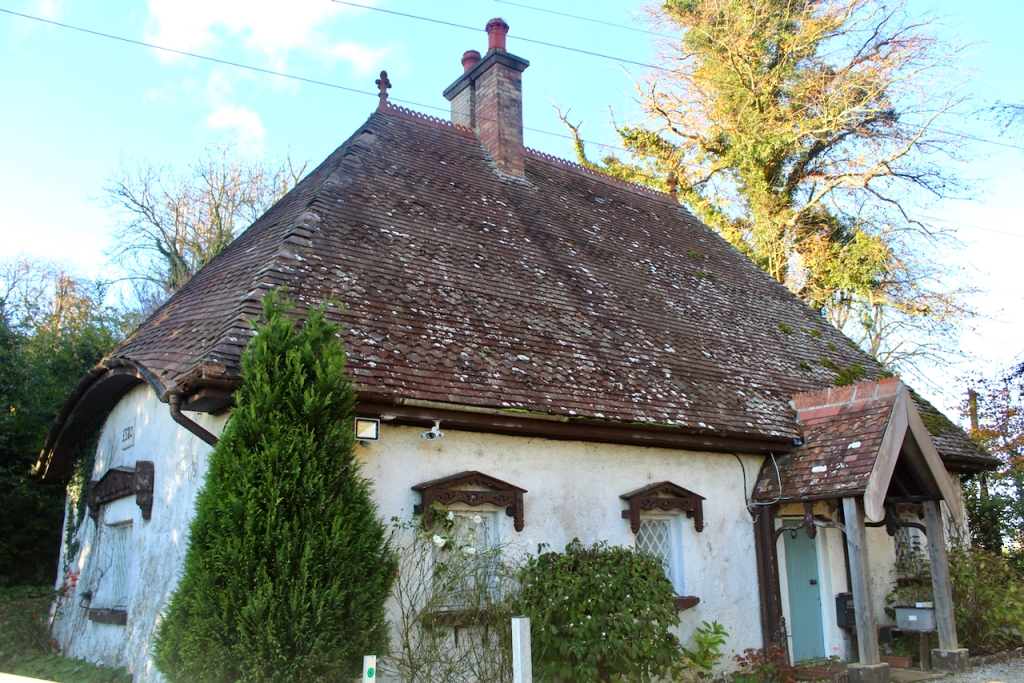
We drove in to the farmyard area as directed by signs and we had to wander around a little to find the house. The gardens are also open to the public and we walked through the walled garden.
The house was built for Charles Hamilton (1738-1818) and his wife Elizabeth Chetwood (or Chetwode), and the name “Hamwood” is formed by joining their two names.

Charles was the son of Alexander Hamilton (1690-1768), MP for Killyleagh in County Down (now in Northern Ireland), who settled in Knock, a townland in Balbriggan, County Dublin. The family of Alexander, despite being MP for Killyleagh, seem to be a different family of Hamiltons from those of Killyleagh Castle, as the Hamwood website will tell us. Hamiltons still live in Killyleagh Castle, parts of which date back to 1180. It came into the Hamilton family in the time of James Hamilton (1559-1643), 1st Viscount Claneboy, County Down. Alexander’s ancestor Hugh Hamilton (1572-1655) came to Ireland from Scotland. The 1st Viscount Claneboy also moved to Ireland from Scotland. Alexander’s brother George built a house at Tyrella in County Down.
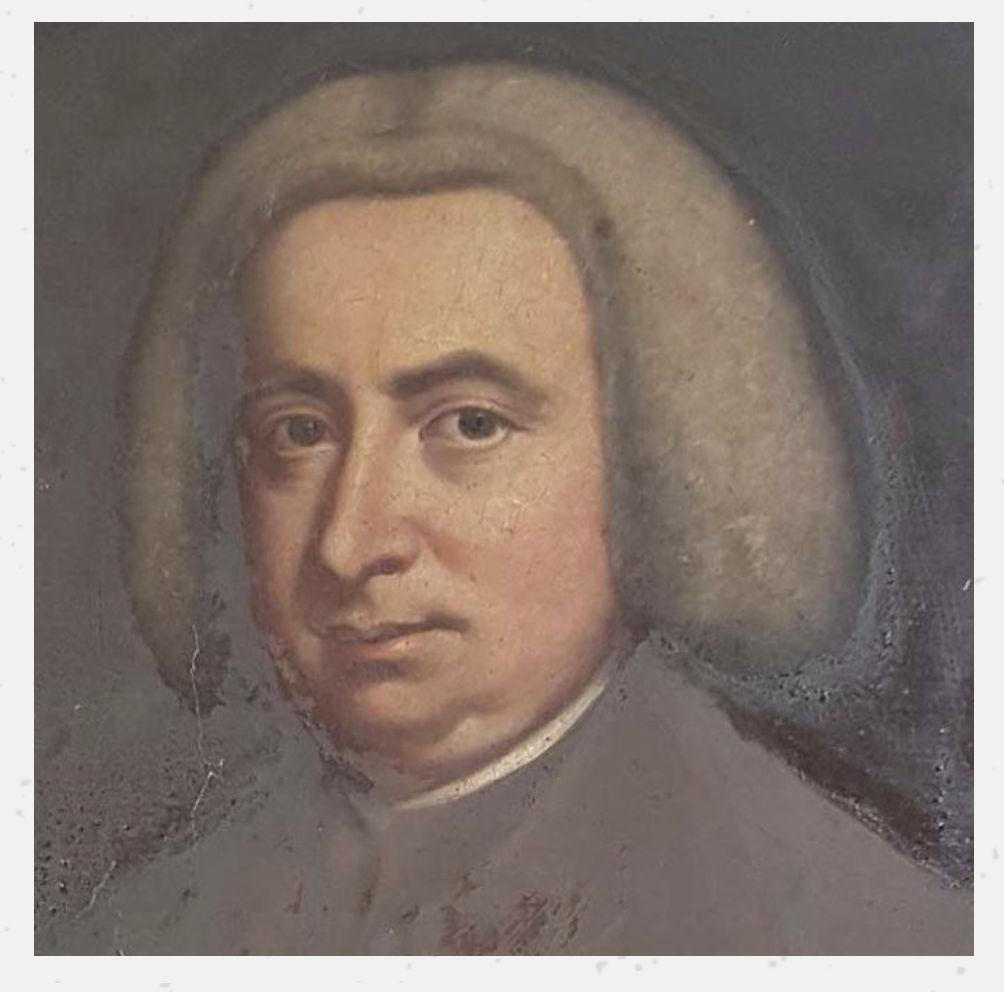

Alexander was a wealthy landowner, owning town lands worth £50,000. He married Isabella Maxwell of Finnebrogue, County Down. The Hamwood website tells us that his son Hugh (1729-1805) became Dean of Armagh and Bishop of Ossory and a professor of Mathematics at Trinity College Dublin.
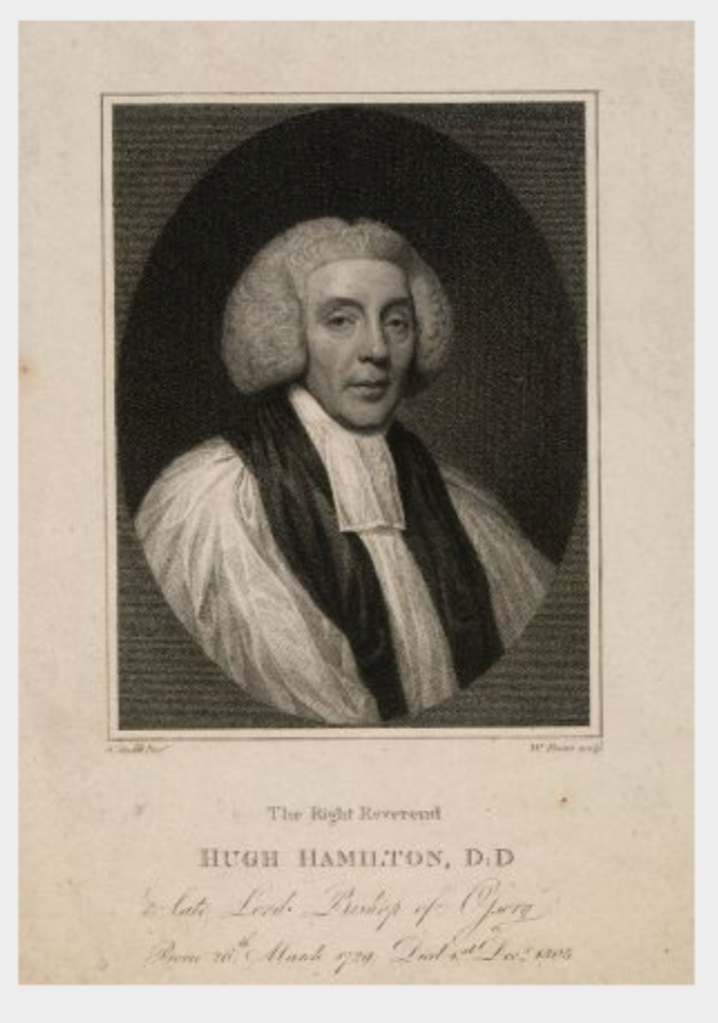
Another son, George (1738-1793), was MP for Belfast in 1769-1776 and settled at Hampton Hall, Balbriggan (which burned down in 1901 but has been rebuilt). George developed the fishing village into a flourishing town with cotton mills and a trading port with a lighthouse. I came across a newspaper article about a book published in 2004 about the Hamiltons of Balbriggan, written by Stephanie Bourke in conjunction with the Balbriggan and District Historical Society, The Hamilton Family and the making of Balbriggan.
A daughter, Anne, married Colonel Henry Caldwell, who fought in Canada under General James Wolfe (1727-1759) in the battle between France and England for control of Quebec. Wolfe died of his wounds, and as Wolfe’s Aide De Campe, Caldwell was sent to England to announce news of the victory over the French. Anne and Colonel Caldwell subsequently settled near Quebec. Later Hamiltons also travelled to live in Canada, which we will see in the house. Henry Caldwell was the son of John, 3rd Baronet Caldwell, of Wellsburrow, Co. Fermanagh.
Alexander’s son Charles, the website tells us, started working life as apprentice to a wine merchant in Portstewart in County Derry. He subsequently started his own business and moved to Mount Venus in Rathfarnham, County Dublin. He married Elizabeth Chetwood. The Chetwoods were from Woodbrook House in County Laois, a fine house which sold recently. Another brother of Charles, Robert, married her sister Hester.
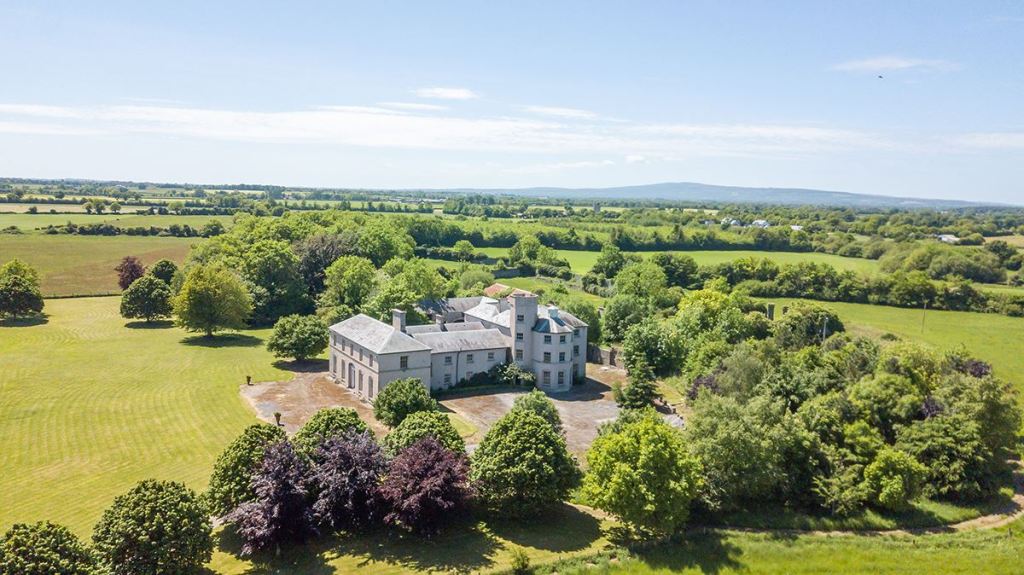
Charles was left a townland in the North of Ireland which he sold for £7,000 and bought land which had been part of the estate of Ballymacoll, County Meath (now an Equestrian stud farm) from James Hamilton. The website tells us that these Hamiltons are not related. James Hamilton was from a family who lived in Sheephill Park in County Dublin, which later became Abbotstown and housed part of the veterinary school of Dublin (and was the reason I lived in Blanchardstown when I was born), and is now a sports centre. This Hamilton family also traces back to Killyleagh, to a younger brother of James Hamilton 1st Viscount Claneboy.

Charles became the land agent for the Archbishop of Dublin and for Lord Lansdowne (William Petty-Fitzmaurice, 1st Marquess of Lansdowne). I’m not sure what dates he worked for the Archbishop of Dublin so don’t know which one it was but it could have been Charles Cobbe who was Archbishop of Dublin from 1743 to 1765, who built Newbridge House in Donabate, not too far from Balbriggan, between 1747 and 1752. The next Archbishop of Dublin (I am assuming it was a Church of Ireland archbishop since Catholic ones would not have a land agent) was only in place for the year of 1765 as he died in office, William Carmichael. The next Archbishop was Arthur Smyth who served for five years until 1771. The next archbishops were John Cradock (served 1772-1778) then Robert Fowler (1779-1801).
Art Kavanagh tells us in his The Landed Gentry and Aristocracy, Meath (published 2005) that Land agents were not paid a salary but were paid between four and five percent of the amount of rentals they collected. On some estates with large rentals this could amount to quite a substantial sum. In addition many agents became middlemen themselves and so made even more profits.
At the time Charles and his family mainly used Hamwood as a summer retreat as he lived in the city of Dublin in 40 Dominick Street. Art Kavanagh tells us that Charles had business interests in Dublin and was the owner of land in Ringsend. He was also involved with Arthur Pomeroy, Viscount Harberton (later of Carberry, Co Kildare), who appeared to be his partner in some land dealings in the Fitzwilliam Square area of Dublin. [2]
The Hamwood website tells us that in 1798 some rebels captured Charles along with the agent to William Robert Fitzgerald (1749-1804), 2nd Duke of Leinster. The Duke’s agent was killed but a local man named O’Reilly, whose family still practice as blacksmiths in the area, recognised Charles Hamilton and asked that Mr Hamilton be spared as “he was more useful (to them) alive than dead.” It was said that this was probably in recognition of his moral, learned and industrious character. As well as being a Land Agent, he farmed his own land.
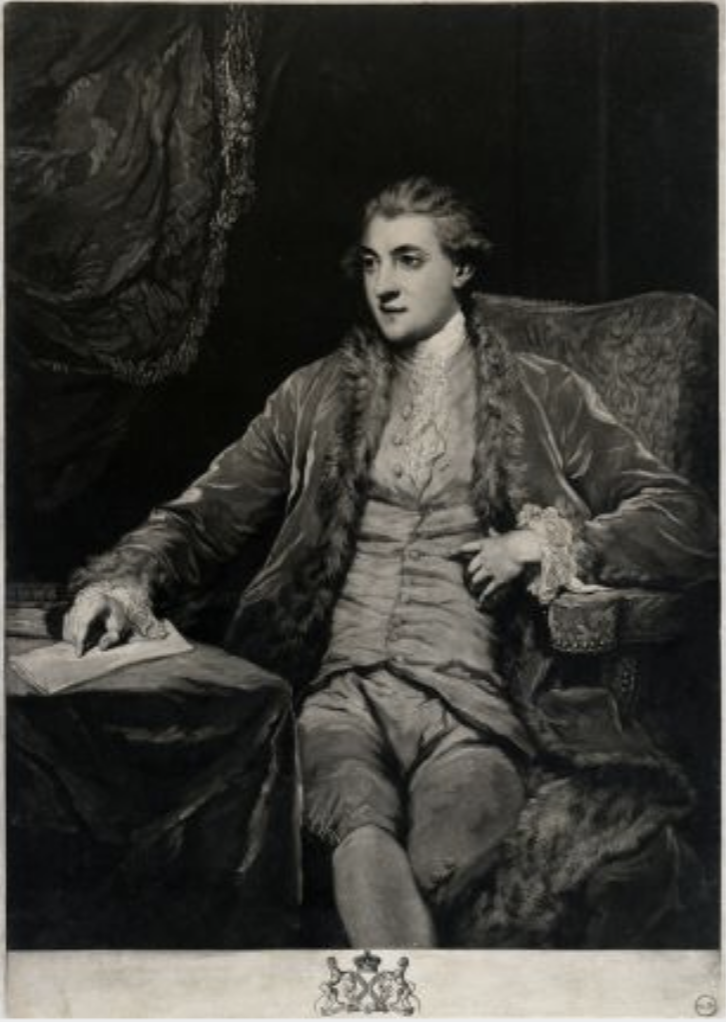
Charles Hamilton suggested to the Duke of Leinster that he fill the now vacant position as his land agent. The Duke owned and lived in Leinster House in Dublin (now the government buildings) and had Carton in County Kildare as his country residence (now a hotel – see my entry Places to visit and stay in County Kildare). This role passed through later generations of Hamiltons until as late as the current owner’s father. The Duke of Leinster donated the granite steps at Hamwood, as well as several trees. The website explains that the site is exposed to strong winds and the wooded surroundings helped to create shelter.
Charles became a member of the notorious “Hellfire Club” which met in the Wicklow hills for drinking, gambling and carousing. He became “toastmaster” of the club and the family still have the gavel which he used to bring the members to order.

Charles and his wife had fifteen children but not all survived to adulthood.
Charles’s son, also named Charles (II, 1772-1857) added the wings to the house and moved the entrance door to the unusual position in one of the pepperpot additions. His wife persuaded him to do this to keep draughts from the house. At some stage, the back of the house became the front, Charles told us.
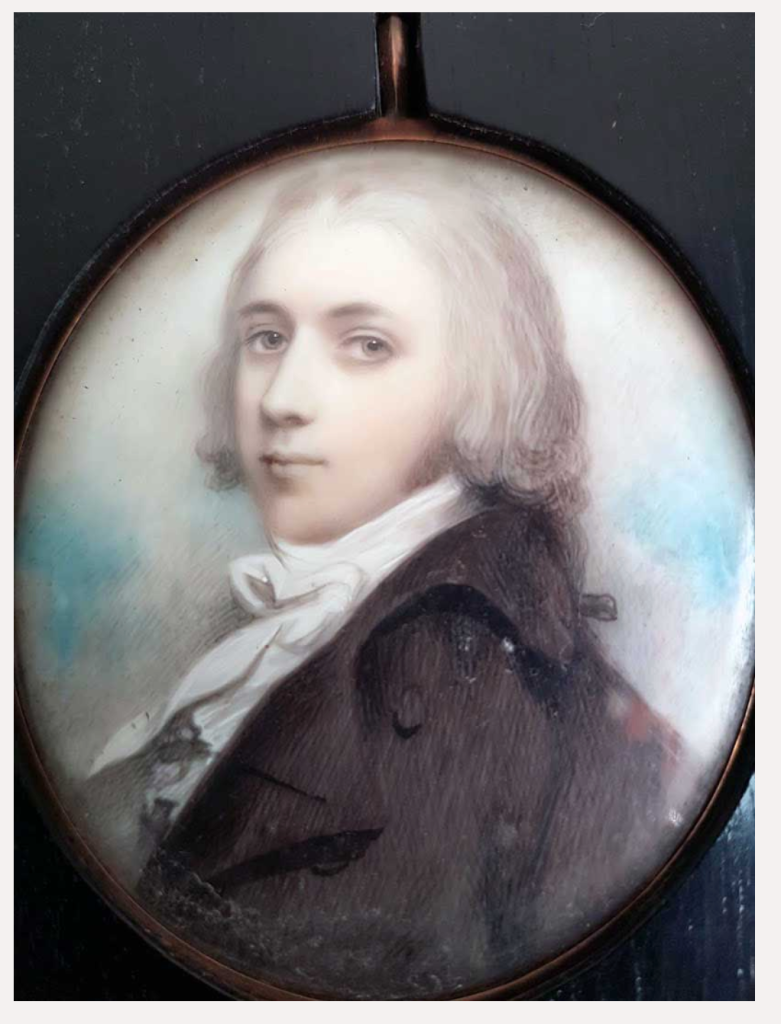
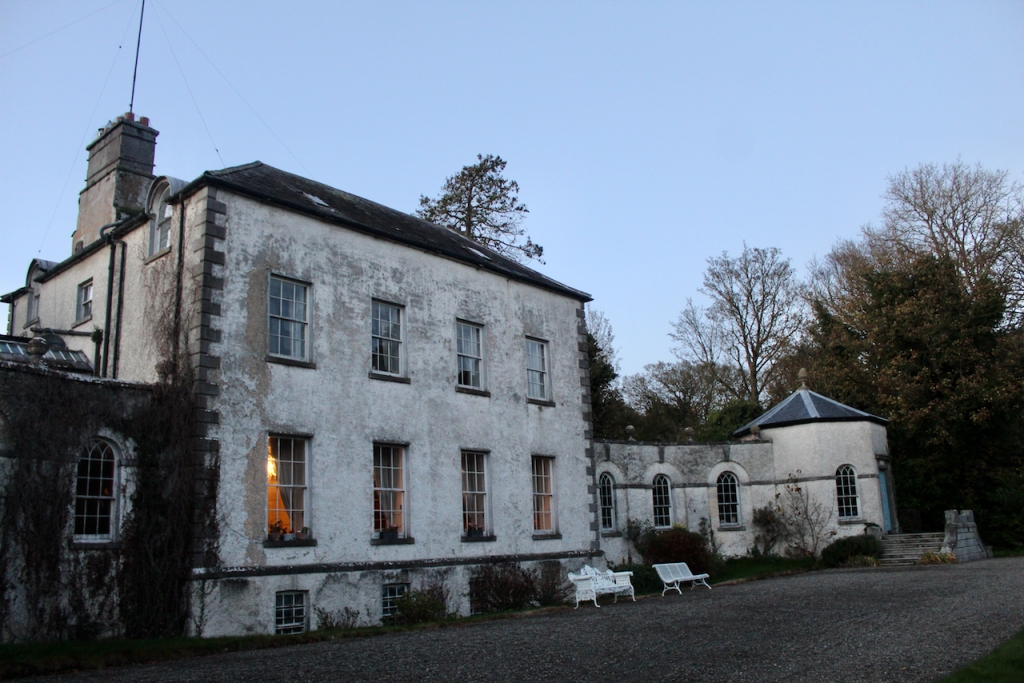
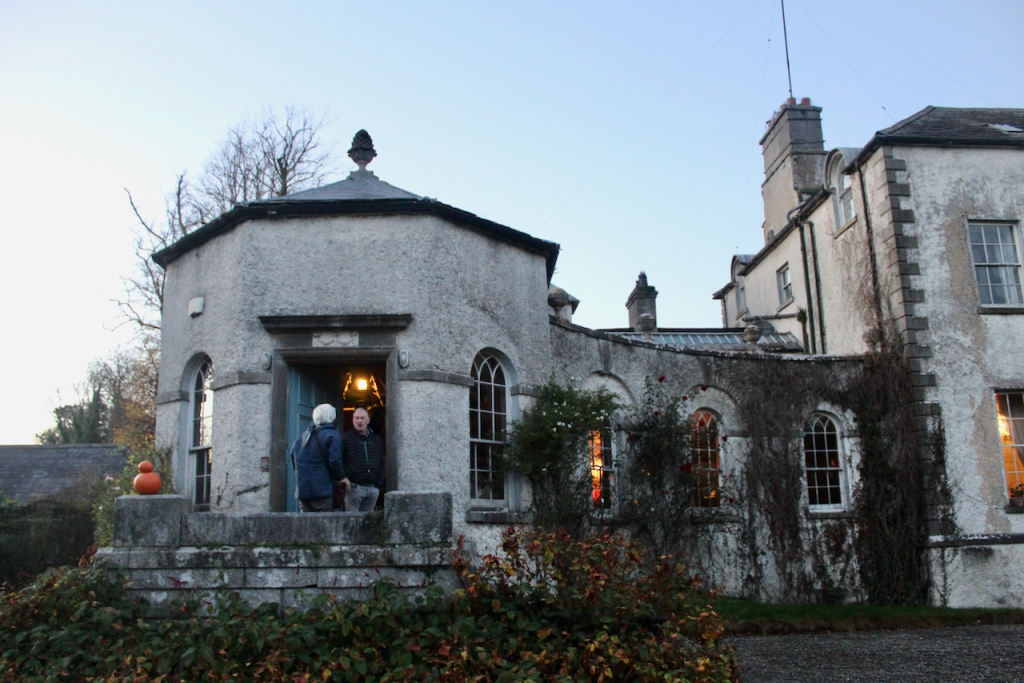

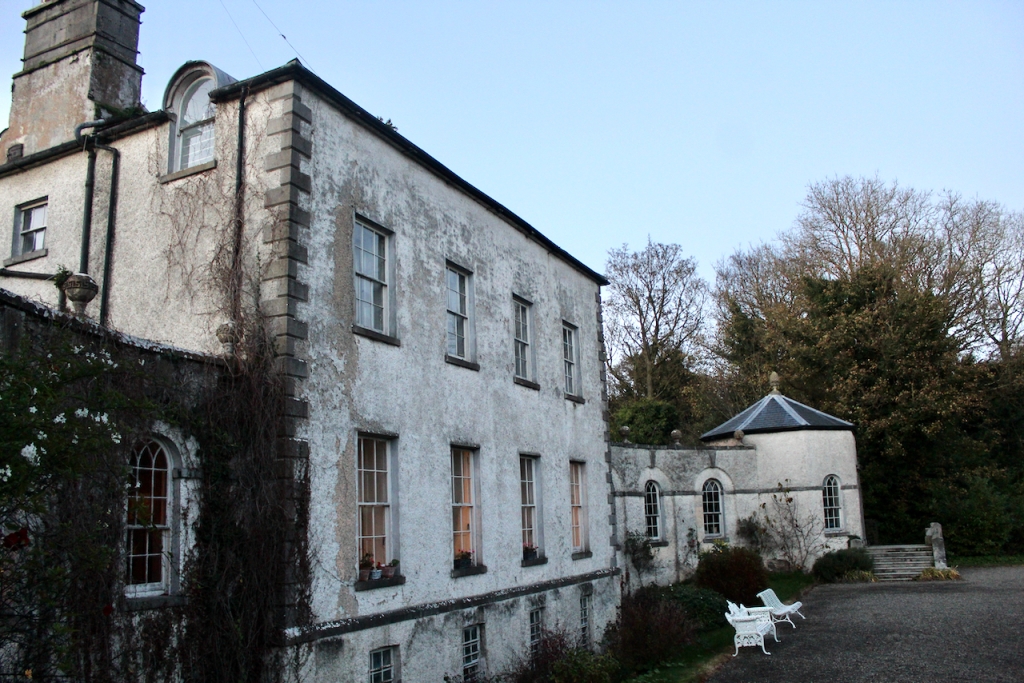
Charles II was a classics scholar and completed his education at Trinity College Dublin before being called to the Bar in 1792. He spent some years in London while practicing as a lawyer before returning to Ireland. In 1801 he married Marianne Caroline Tighe (1777-1861) of Rosanna, Co Wicklow, daughter of William, MP for Athboy and Sarah Fownes, who inherited Woodstock in County Kilkenny. She was the cousin of the poet Mary Tighe, whom we came across when we visited Altidore in County Wicklow.
Another son of Charles I and Elizabeth Chetwood was George (d. 7 January 1839), who emigrated to Canada and was founder of Hawkesbury Lumber Mills. The moose heads in the front hall in the pepperpot entrance come from Canada.
Another son, William Henry, moved to Quebec in Canada also. Sons Robert and John became merchants in Liverpool.
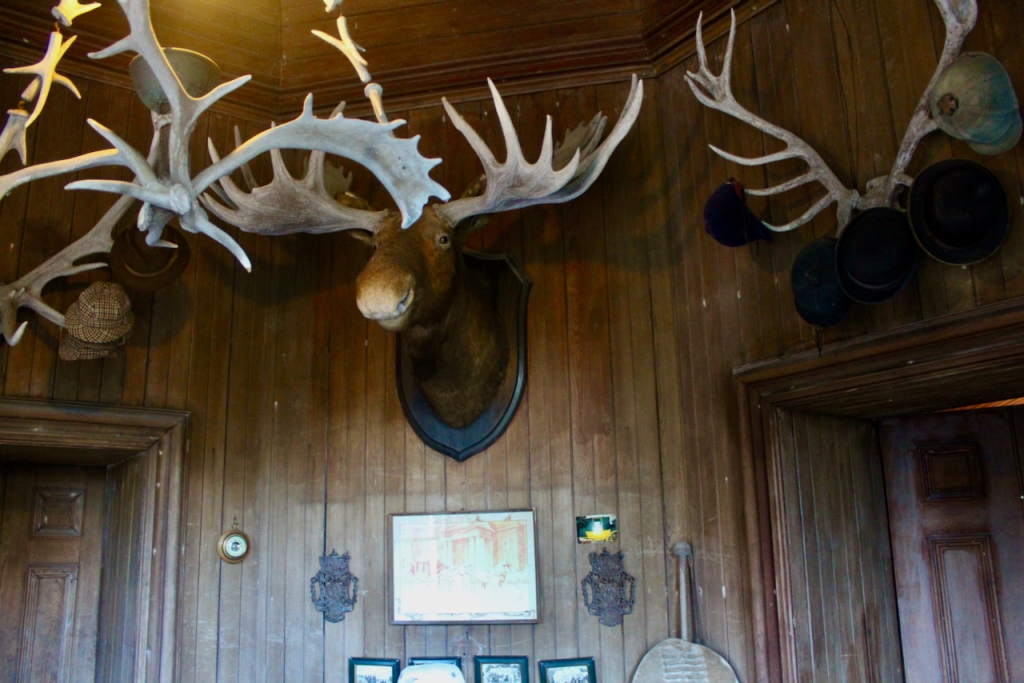
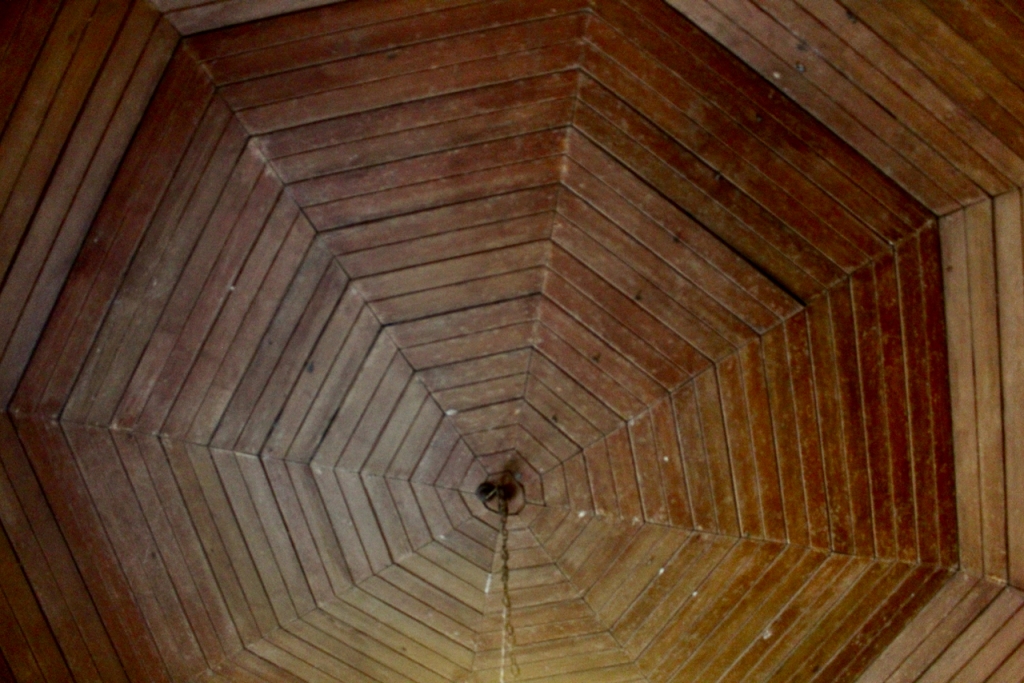

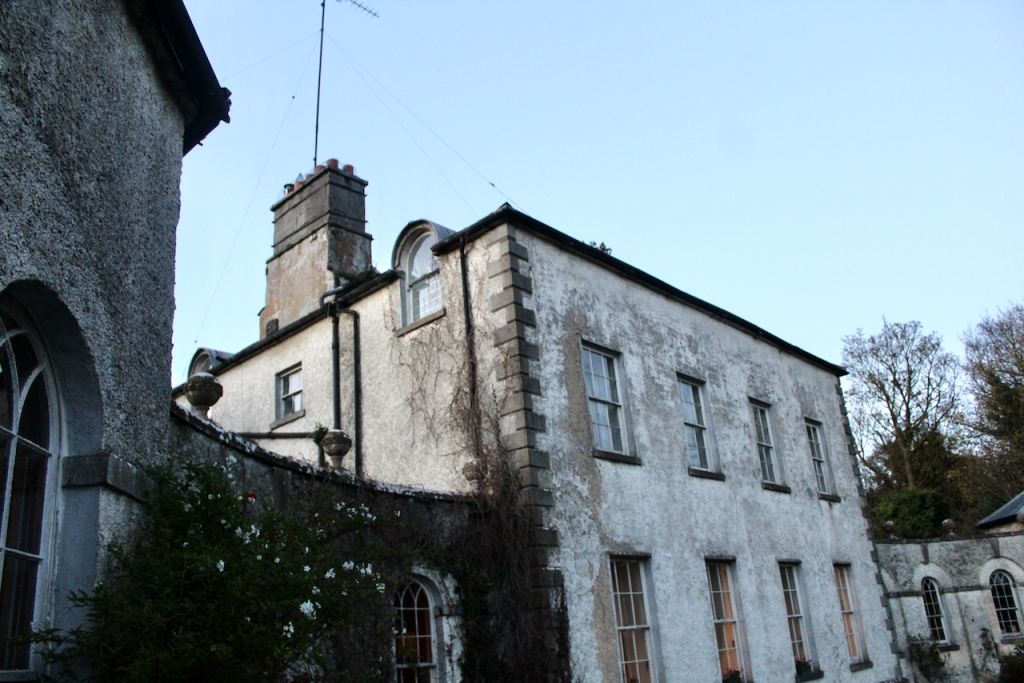
The website tells us that Charles II and Marianne Caroline, who went by Caroline, set about making major improvements to Hamwood, extending the existing house and adding the wings, and also the interior adding ornate furniture wall coverings etc. Much of the furniture was procured for the house, some of it specially designed and fitted.
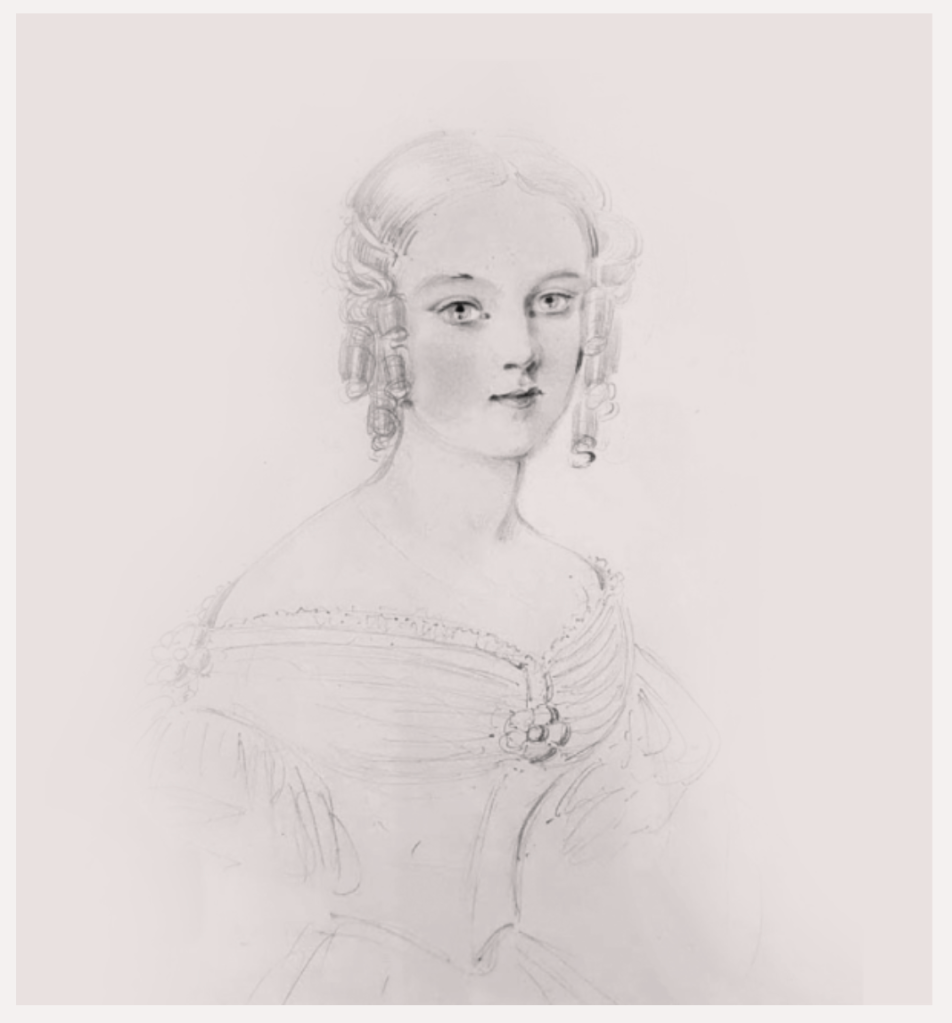
Charles II was responsible for laying the foundations of the Gardens, and from her diaries, we know his wife Caroline was also very involved. The website tells us about the walled garden, which was not at its best when we visited since it was November:
“The walled garden began in 1777 when Charles Hamilton I built its walls. Part of the wall existed as stone, but this was later added to in brick. To make it look like a seamless brick wall, the stone walls were rendered and the brickwork painted on. At the time, the walled garden was mainly used to grow fruit, vegetables and flowers for the household. Charles II created the rock garden and with his wife Caroline, they designed the triangular shaped Knot garden. Charles III, otherwise known as Charles William, was an amateur artist as was his wife Letitia Armstrong and created to the front and rear of the house a parterre – an intricate design of flowers in beds which would resemble a cluster of fine jewels at a distance.“
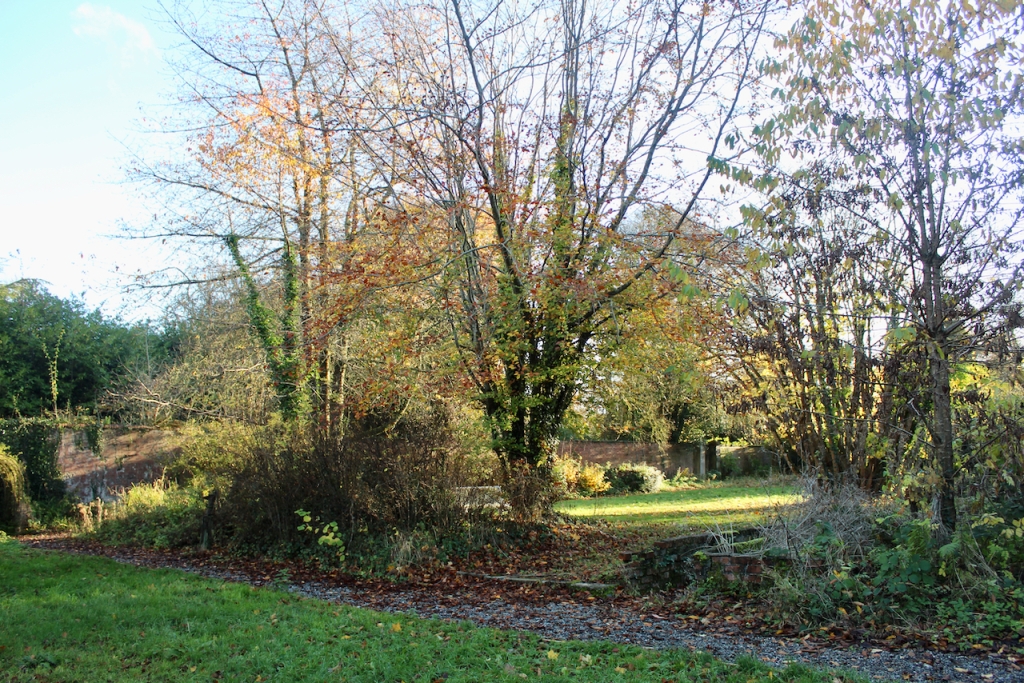
Caroline was an artist who became especially well-known for her satirical sketches. The website tells us about her:
“Caroline spent much of her younger years in London and took lessons in art from the notable printmaker and portrait painter John Spilsbury (1737-1812) who had taught at Harrow where her brother was at school, and later Maria Spilsbury (1776-1820), his daughter. She became a skilled artist, especially in creating pen and ink drawings of Irish society of the day, using a satirist angle on such subjects as religion, education and the ruling classes.
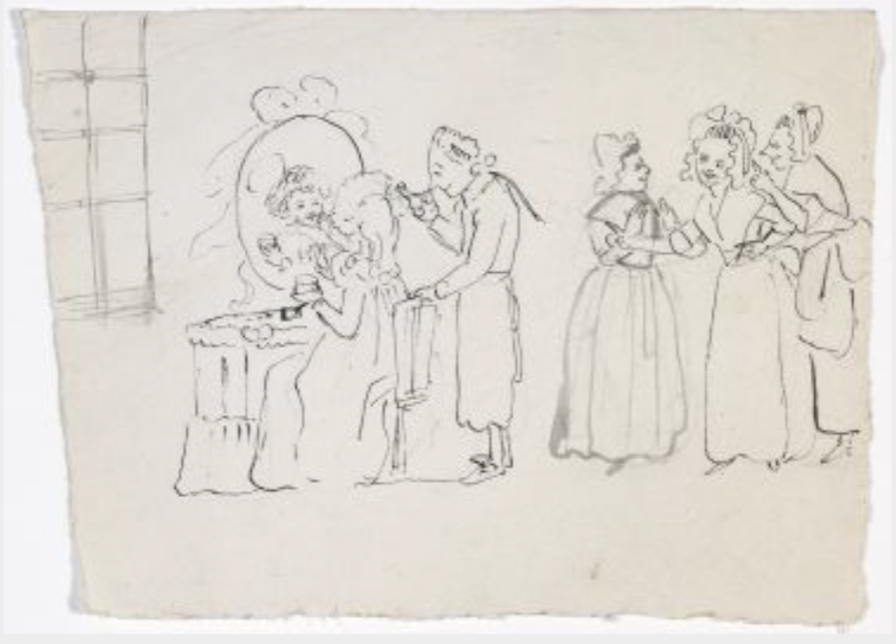
The website continues: “After rearing and educating her six children, Caroline dedicated her time to the improvement and development of Hamwood House and its gardens, her art and, in particular, her writing. Her Memoirs are one of the most significant records of Irish life of the time, and in addition, she became heir to the diaries of the Ladies of Llangollen, which are now in the collection of the Hamwood papers held in the National Library, Dublin. Caroline’s cousin, Mary Tighe (1772-1810), was an accomplished poet best known for her poem, Psyche. Her artistic talent and to some extent, that of her husband, Charles III, passed down to her great-grandchildren, Eva and Letitia.“

The “ladies of Llangollen” were Eleanor Butler (1739–1829) and Sarah Ponsonby (1755–1831) – Sarah grew up in Woodstock in County Kilkenny, with her cousins, which was the house inherited by Caroline’s mother – it is now a ruin but has wonderful gardens, see my entry for Places to visit and stay in County Kilkenny. The two friends ran away together and set up house in Llangollen, Wales, and became famous for their audacity, and were visited by many people including Percy Bysshe Shelley, William Wordsworth and the Duke of Wellington.
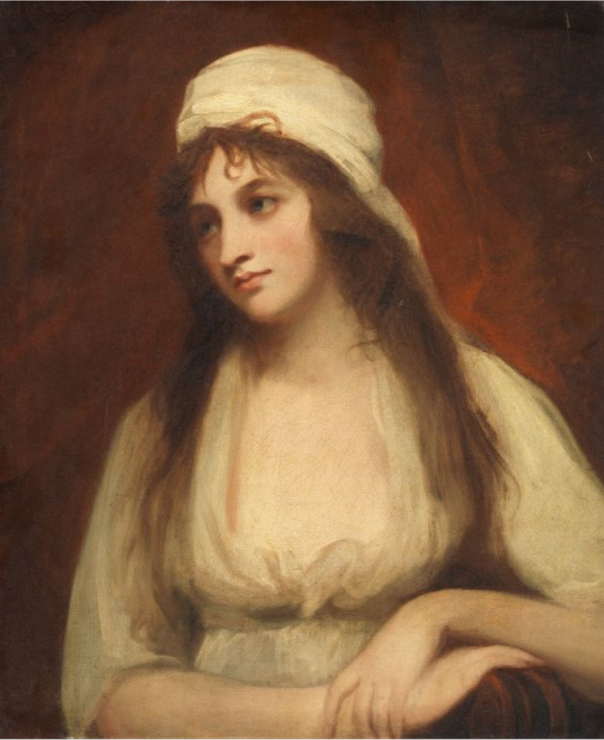
Caroline wrote a history of her family, detailing the lives of Theodosia and Mary Blachford and Sarah Ponsonby. Her memoir was published in 2010 as the edited volume Reminiscences of Marianne-Caroline Hamilton (1777–1861).
Caroline wrote and drew in a satirical style, providing a critical depiction of the Anglo-Irish ascendancy from that period. Her best known works include Domestic happiness as acted in the city: a tragic comic farce, The Kingston to Holyhead packet, and Society.
Charles II continued as Agent for the Earls of Leinster. The 2nd Earl died in 1804. The next, 3rd Duke, was Augustus Frederick FitzGerald (1791-1874).
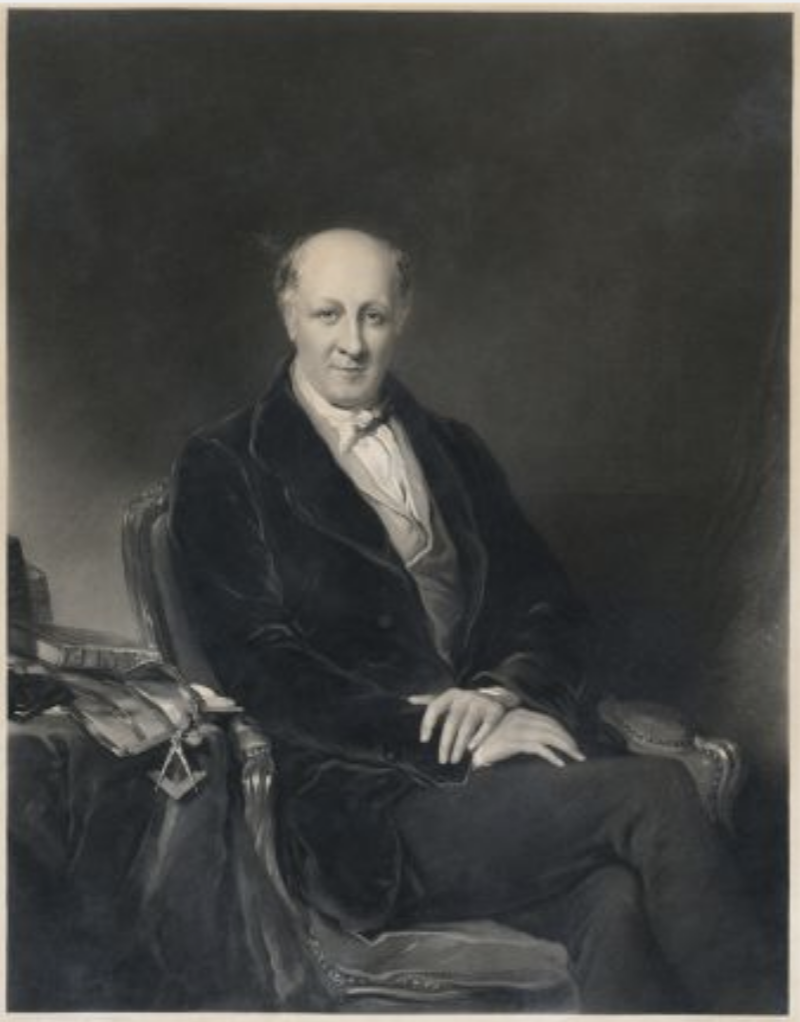
Moving the front door to one of the wings created a double drawing room that runs along the entire length of the facade. [3] The double drawing room is separated into two by an arch, an alteration possibly made by Caroline Hamilton in the 19th century. [see 1] It is a large comfortable room, not overly formal.

David Skinner of Skinner and Sons, specialists in wallpaper design and conservation, advised on the decoration of the dining room where a rustic red wallpaper has replaced a cream colour. [see 1]

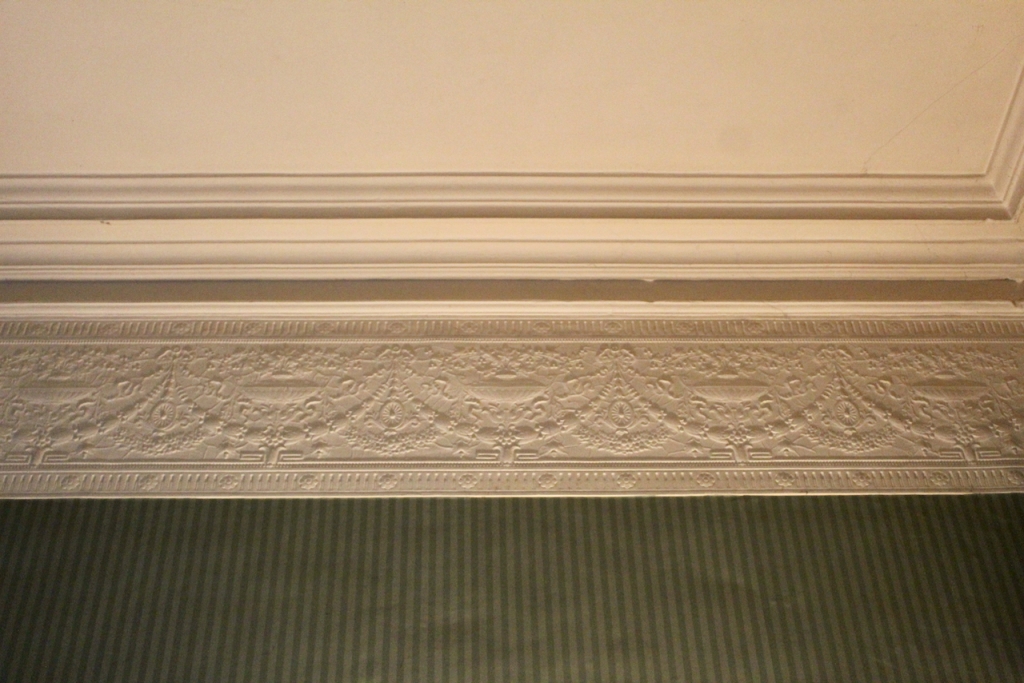
Charles and Caroline’s daughter Sarah married Reverend Francis Howard, son of the 3rd Earl of Wicklow. Sarah was his second wife, as he had been previously married to Frances Beresford, who died in 1833. Sarah’s sons became the 5th and 6th Earls of Wicklow, who would have inherited the marvellous Shelton Abbey, which was gothicized by Richard Morrison.
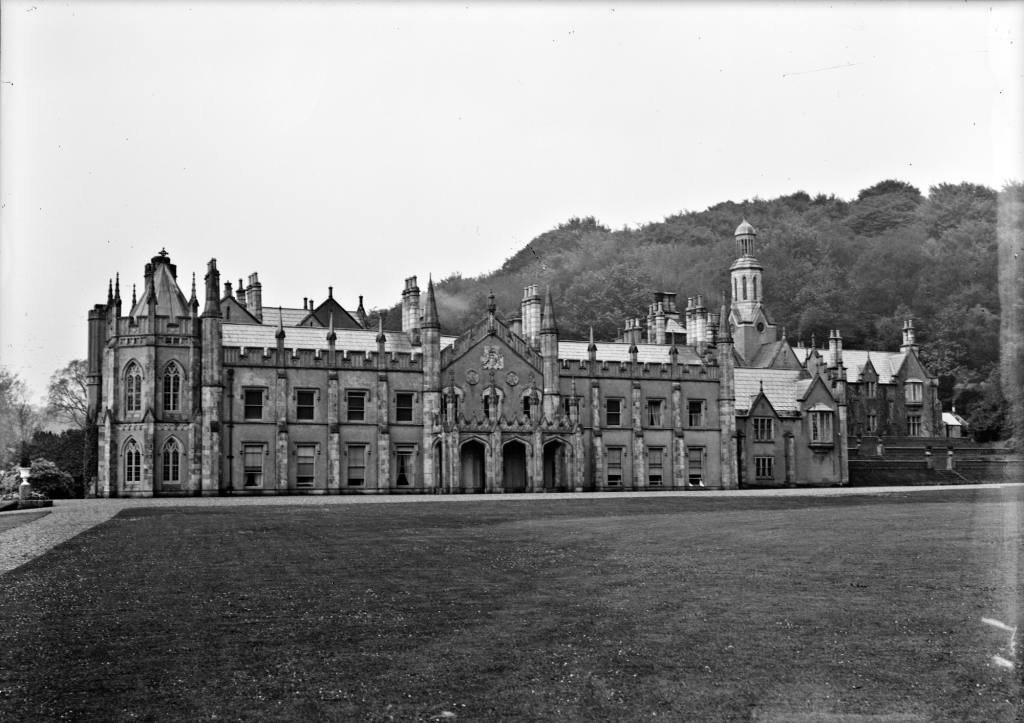
Their daughter Caroline married twice but had no children and another daughter, Mary, remained unmarried.
Of their sons, Charles William (1802-1880) inherited the property when his father died in 1857. He continued his father’s position as the land agent for the 3rd Duke of Leinster. He married Letitia Charlotte Armstrong of Mount Heaton, County Offaly (now known as Mount St. Joseph’s) in 1841. The website tells us of Charles III:
“He had a keen interest in Agriculture and was deeply involved in the Royal Dublin Society. He was particularly concerned about the state of Agriculture in the country prior to the Famine of 1845 and he urged the Repeal MP William Smith O’Brien to set up agricultural societies and colleges throughout Ireland to instruct farmers in modern methods. He corresponded frequently with Prime Minister William Gladstone about the terrible conditions caused by the potato blight and deplored the lack of assistance given. Although the effects were not nearly so bad in Leinster, soup kitchens were available to those who needed it, one being at Hamwood.
“One of Charles William’s passions was painting and he toured extensively, visiting Scotland and France, where he was arrested by the French whilst painting a warship in Antibes harbour. Presumably he convinced them he was simply an artist and no spy and was released!
“At Hamwood he planted the Pine Walk ca 1860, at a time when trees were becoming available from across the globe particularly from North America and the Himalayas. A Monterey Pine still stands among various Cedars, Sequoia and large Pines lining this Walk.“

The 3rd Duke of Leinster died in 1874 and then Charles William continued as Agent for Charles William FitzGerald (1819-1887) 4th Duke of Leinster. and then for Gerald FitzGerald (1851-1893) the 5th Duke. Charles told us that the wife of this Duke, Hermione, daughter of William Ernest Duncombe, 1st Earl Feversham of Ryedale, County York in England, was rather wild!
The lives of the Hamiltons of Hamwood were closely tied to the Fitzgeralds of Carton. Charles told us of the next generation of Fitzgeralds: the first son was mentally unstable and unable to manage the property, the second son died in the first world war, so the third son, Edward FitzGerald (1892-1976), 7th Duke of Leinster, inherited when his brother died in 1916. The oldest son, the unstable 6th Earl, died in 1922.
Charles and Letitia had several children and the artistic bent passed to their grandchildren. Their heir was another Charles, Charles Robert (1846-1913). He married Louisa Caroline Elizabeth Brooke, daughter of Francis Richard Brooke and Henrietta Monck. The Hamwood website tells us Charles:
“… married Louise Brooke in 1874 who had 10 children, of whom 2 boys died in infancy, one being the first born and heir. The two chestnut trees in the Lawn field seen from the Trail were planted in their memory. There were 6 daughters among whom were the exceptional artists Letitia and Eva, and of the boys, Gerald Charles the future heir, and Freddie.“
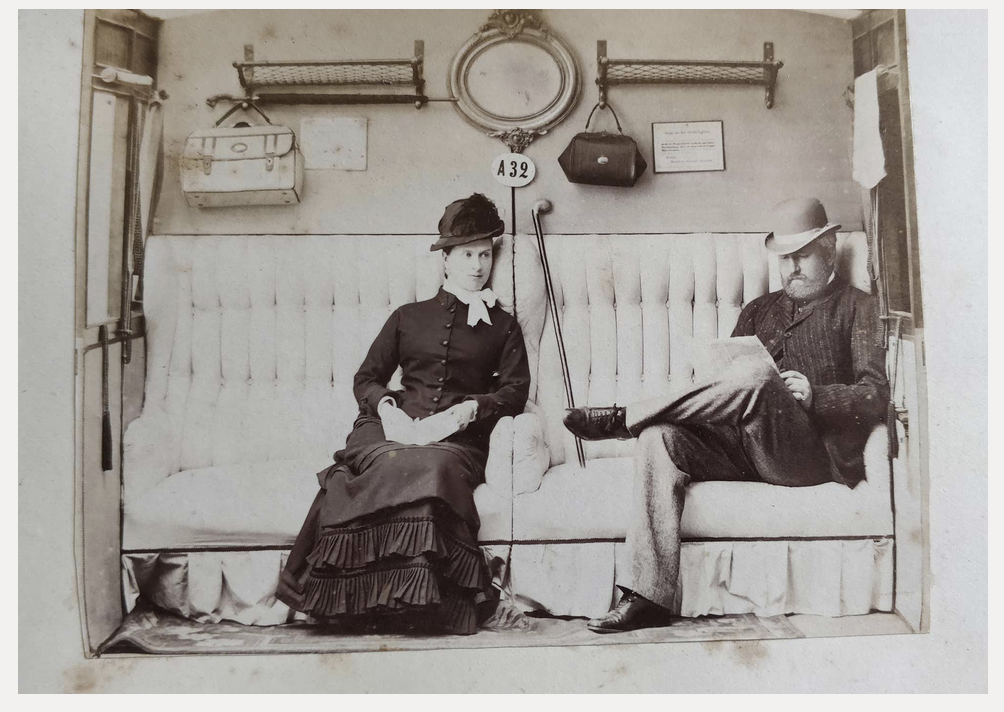
The website tells us of Charles Robert’s development of the garden:
“Charles Robert was educated at home by a governess and at the age of 17 he went to Trinity to study law. He was a member of the Kildare Street Club and was passionate about the garden at Hamwood, where he transformed the Walled Garden, and in order to create an impact he employed a head gardener from Kew Gardens in London. He gained a great deal of help from his large family, particularly Connie (Constance) [b. 1883 and did not marry], who took up landscaping professionally.“
“Charles Robert travelled with his wife to the continent frequently and at times further afield to visit relations in Canada near Montreal. He corresponded with Kew Gardens in London and in particular with Sir Frederick Moore at The Royal Botanical Gardens Glasnevin. Sir Frederick was a Keeper of Glasnevin from 1879-1922. Charles IV and F.W. Moore became well known to each other and traded extensively in exotic and rare plants and trees discovered by the ‘Plant hunters’ of the day.“
The Hamwood website has great entries about the daughters Eva and Letitia:
“Eva Henrietta Hamilton (1876-1960) was born and reared at Hamwood, as was her sister, Letitia. One of five sisters and two brothers, only one sister, Lily, got married, with Eva and Letitia becoming established artists. Both fought for recognition in a society where art was considered as a male preserve and women artists were not treated as equals. Eva was an exceptional portrait artist having studied under Sir William Orpen ( 1878-1931) at the Dublin Metropolitan School of Art (DMSA) which she entered in 1907 at the age of 31 and later, under Henry Tonks, at the Slade in London. Many of her portraits were commissioned by members of her extended family and their social circle. Normally painted against a simple background, Eva’s skill was in reading the character of her sitters and transferring that on to her canvas. With the coming of independence in Ireland in 1922, the market for these type of portraits was much reduced and Eva switched her attention to landscapes which, although not particularly innovative in their production, were attractive and well observed.“

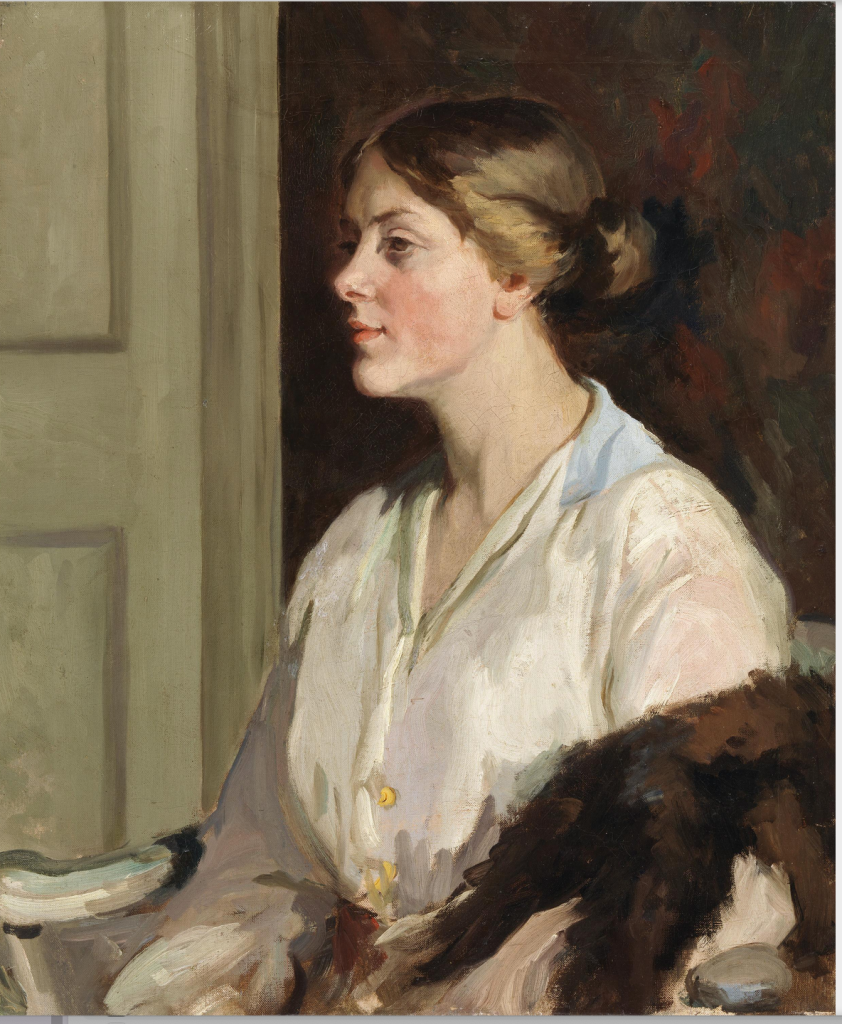
The website continues:
“Eva was the first of the sisters to exhibit her work, showing a portrait and a figure subject in 1898 at the annual exhibition of the Water Colour Society of Ireland (WCSI). Watercolours were then seen as an acceptable medium for women artists. Her works were shown in London, Paris and Brussels as well as the Irish International Exhibition in Dublin in 1907. She first exhibited at the Royal Hibernian Academy (RHA) in Dublin in 1904 where she continued to exhibit until 1945.
With the death of their mother in 1922, Eva assumed much of the housekeeping role and had less time to devote to her painting. The sisters lived together for most of their lives, in their later years in a series of large rented houses. Among these was Fonthill in Palmerstown, now the offices of the Ballymore construction company. In 1946, they made their final move to Woodville in Lucan, an eighteenth century house designed by the architect, Richard Castle (1690-1751). Fondly known as ‘the Aunts’ nest’ they continued to give memorable parties in their rather eccentric lifestyles. A tree with many sweeping branches stood in the garden from where old umbrellas hung, and in a rather artistic way resembled a tree with huge drooping fruit!“
I found a painting of the house online from a sales catalogue of DeVeres auctioneers, by Letitia.
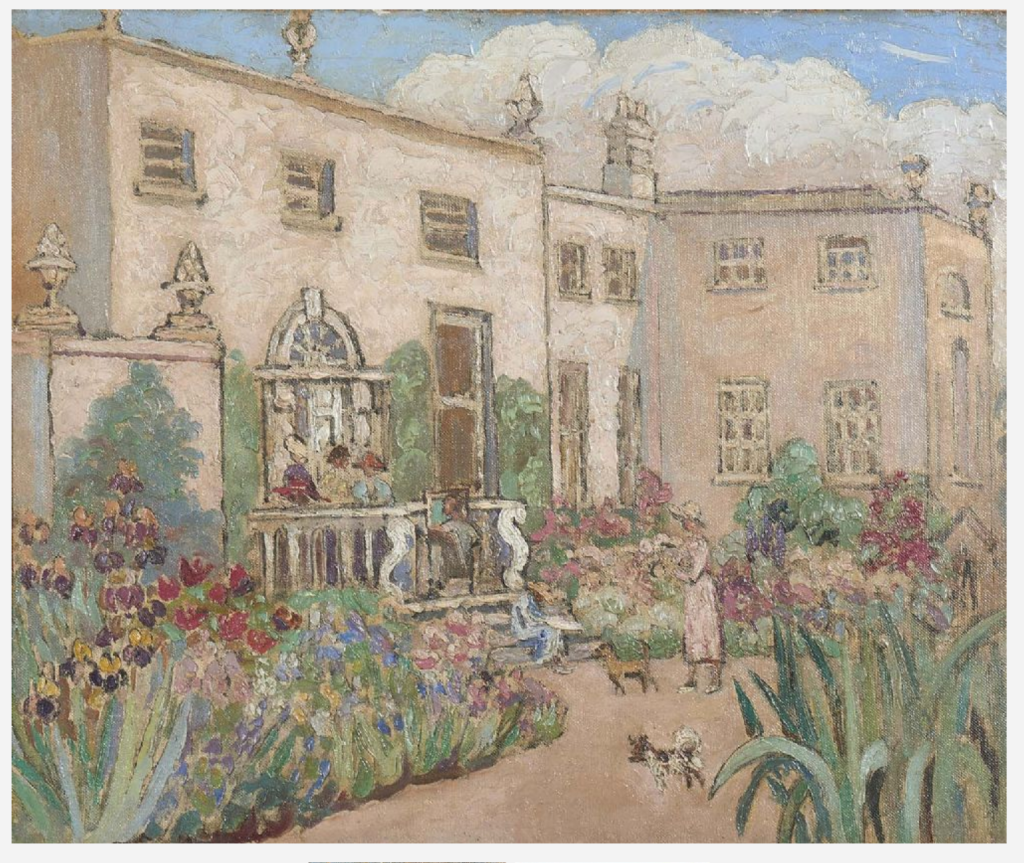
The website also has an entry about Letitia:
“Letitia Marion Hamilton (1878-1964) was a talented and prolific landscape artist who, like her sister, studied under Orpen in the DMSA. Compared to Eva, she remained less influenced by him and more by the works of European artists that she saw during her time abroad. An inveterate traveller, she made trips to France, Belgium and Holland before the war in Europe curtailed these visits... With the cessation of hostilities, Letitia’s travels recommenced with trips abroad, often accompanied by Eva. During the 1920s, she travelled widely in France, Italy and Yugoslavia. She visited Venice for the first time in the autumn of 1923 and during the 1930s made regular visits to the city and northern Italian lakes.
“…they both blazed a trail for women artists in Ireland at a time when it was dominated by their male counterparts such as Sean Keating, Paul Henry and Jack Yeats. Eva and Letitia’s images of pre-war Europe and scenes from Irish towns and villages preserve a way of life that has now vanished for ever.“
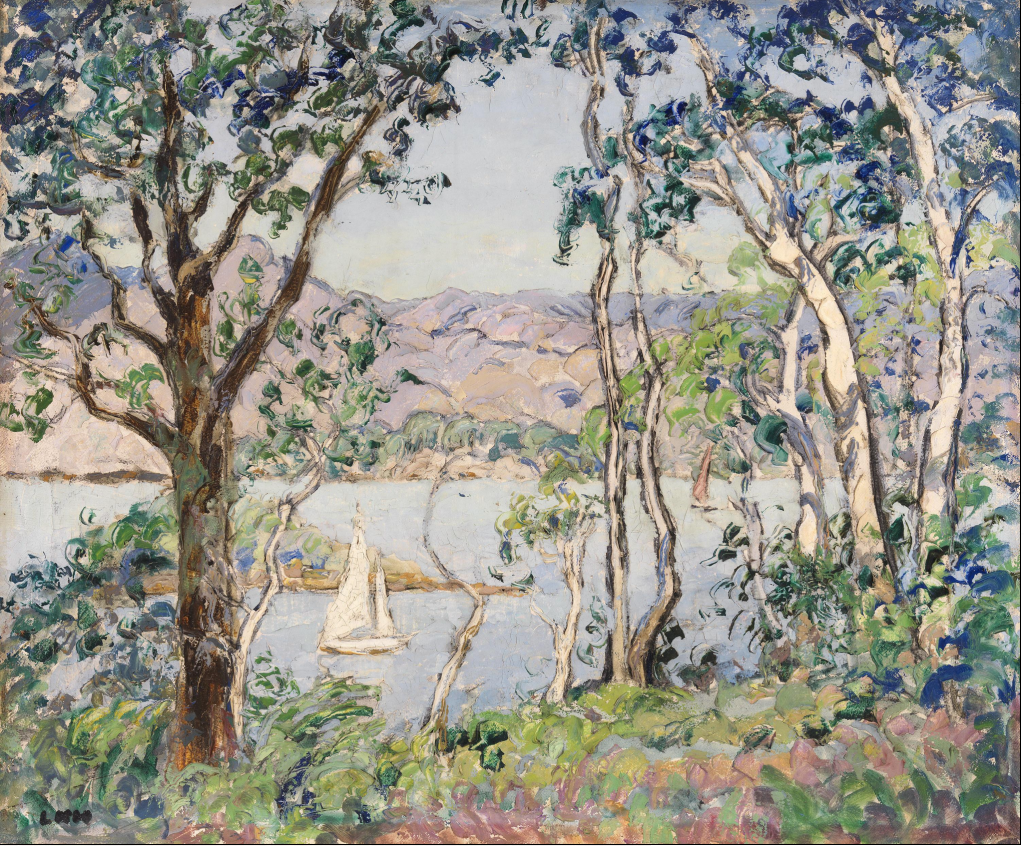
Letitia won an Olympic medal in the 1948 Olympics, the only Irish medal winner that year, for Art featuring sport! Unfortunately that’s no longer an Olympic “sport.”
Their brother Francis Charles (1877-1961) was heir to Hamwood. He studied agriculture in England and acted as Land Agent for some estates in England before returning to Hamwood after the death of his father in 1913. There he continued in the position of Land Agent to the Duke of Leinster: from 1916 he would have been Agent for Edward FitzGerald (1892-1976), 7th Duke of Leinster. Mark Bence-Jones tells us that
“[The] 7th Duke was unable to live here having, as a young man, signed away his expectations to the “50 Shilling Tailor” Sir Henry Mallaby-Deeley, in return for ready money and an annuity. As a result of this unhappy transaction, Carton had eventually to be sold. It was bought 1949 by 2nd Lord Brocket…” [4]

A distant cousin from the family who moved to Hawkesbury in Canada, Violet Travers Hamilton, travelled to England to “do the season,” and Francis Charles was instructed to escort her. He fell in love and they married.
The Hamwood website tells us that:
“Violet died prematurely in 1947. A few years later Francis Charles married Rosamund Bauer who built up Hamwood’s dairy herd and helped see the estate through some difficult times during post war depression... Francis Charles died in 1961 and left the estate to his son Charles.“
Charles (1918-2005) was called “The Major” due to his time in the Indian army, and he served in World War II. Like his father, he also acted as Land Agent to some properties in England before returning to Hamwood. He returned to Ireland and lived in Galway where he was agent for Clonbrock, before returning to Hamwood in 1963, following the death of his father. He also acted as Land Agent for the Conynghams of Slane for a period. Although Carton was sold by the 7th Earl he continued to work as Agent. He may have met my grandfather, as my Grandfather John Baggot of Aghaboe and Abbeyleix in County Laois kept cattle there at some point!
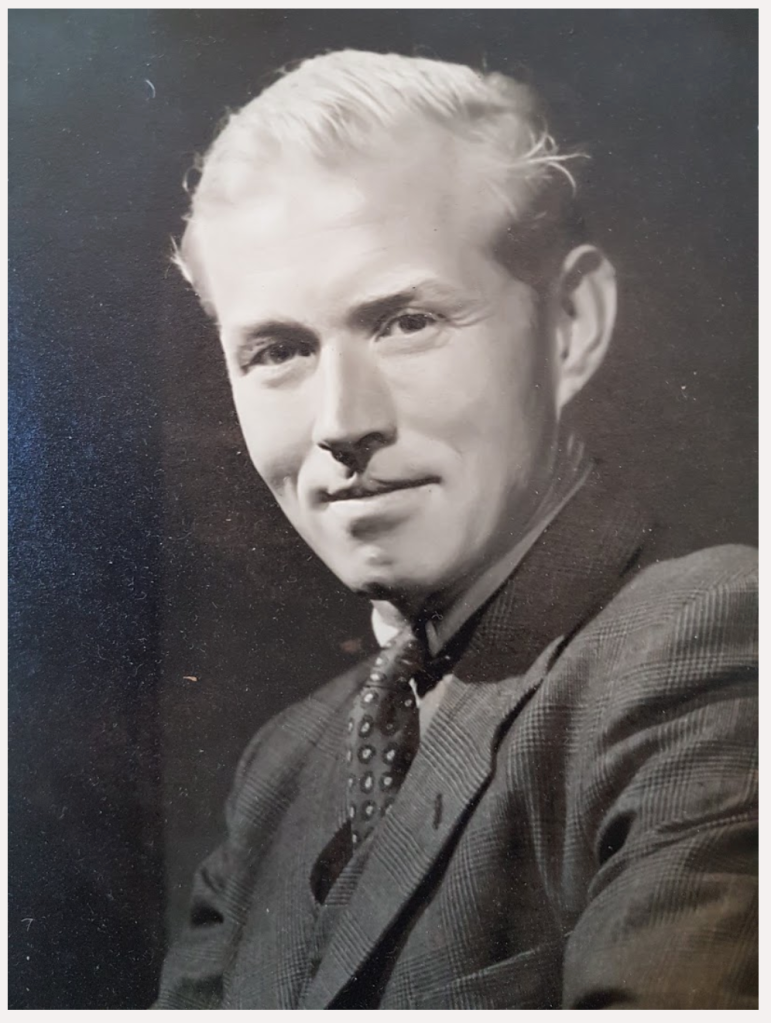
In 1958 Charles married Anne Spicer from Carnew Castle, County Wicklow, where her family moved from England after the second world war. Her family had ties to Ireland, where they holidayed when she was a child, and William Wellesley-Pole (1763-1845) 3rd Earl of Mornington, of Dangan Castle in County Meath (now a ruin), the older brother of the Duke of Wellington, was an ancestor.
Charles took an interest in the garden and added to the plant collection and he ran the farm and bred cattle. Charles, who now lives in the house and showed us around, is their son. He continues the upkeep of the house, gardens and farm. He has created a woodland trail for visitors, and runs a seasonal courtyard café, Café des artistes. The family host events and have opened allotments. One can buy membership to have regular access to the gardens and café.
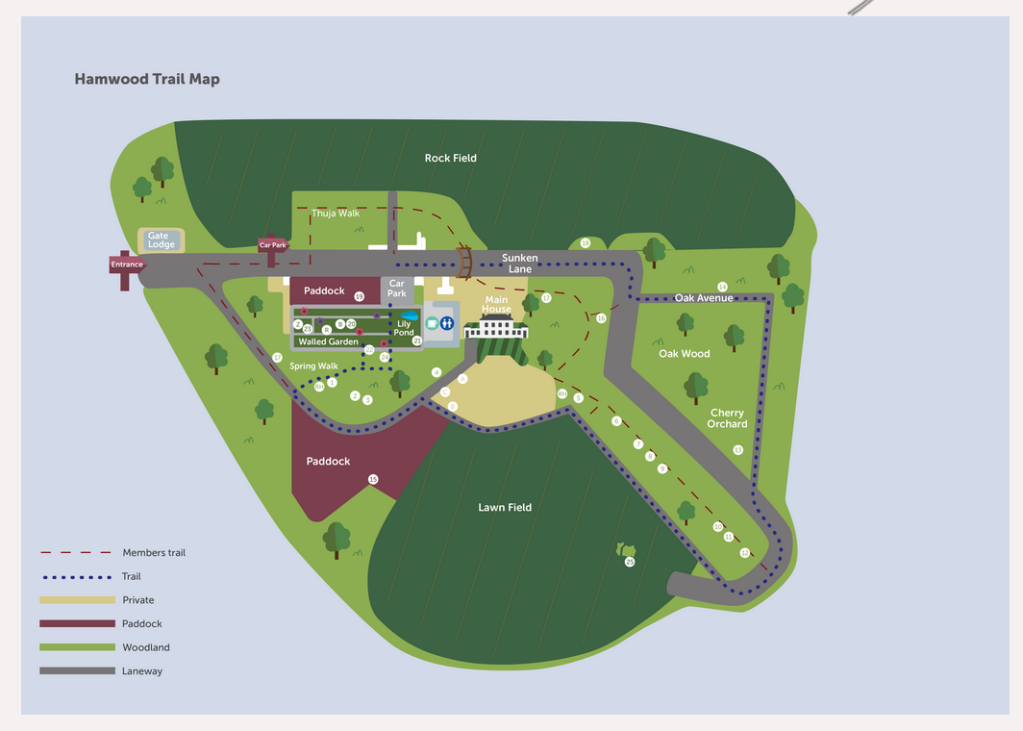
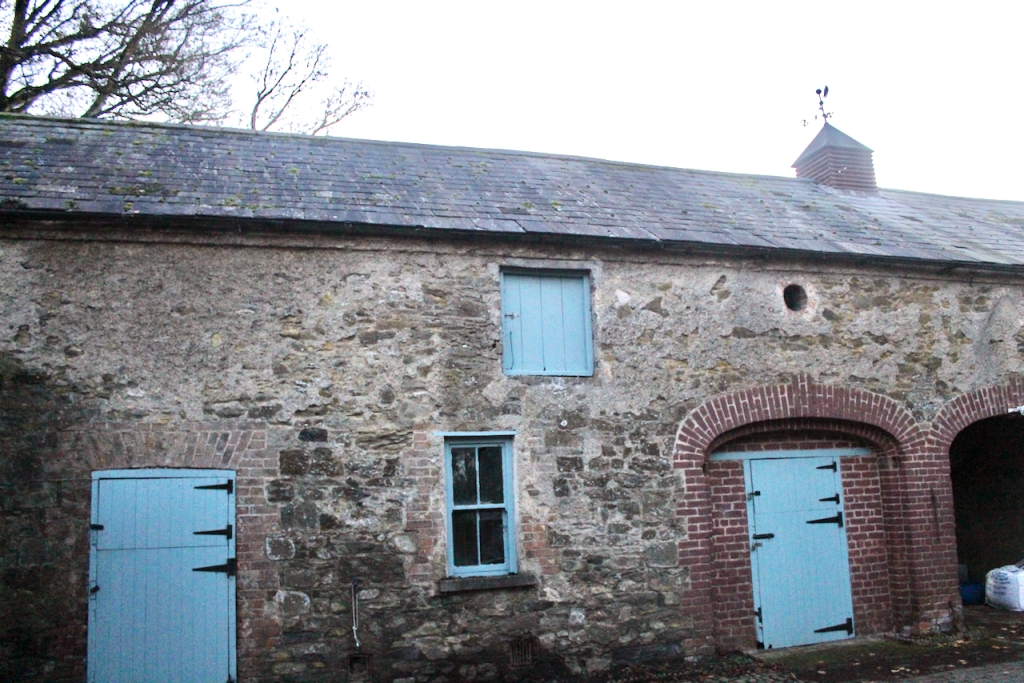
[1] Great Irish Houses (Forewards by Desmond FitzGerald and Desmond Guinness) published by IMAGE Publications in 2008
[2] p. 117, Kavanagh, Art. The Landed Gentry and Aristocracy, Meath, 2005, published by Irish Family Names, Dublin 4.
[3] http://www.ihh.ie/index.cfm/houses/house/name/Hamwood
[4] Bence-Jones, Mark. A Guide to Irish Country Houses (originally published as Burke’s Guide to Country Houses volume 1 Ireland by Burke’s Peerage Ltd. 1978); Revised edition 1988 Constable and Company Ltd, London.